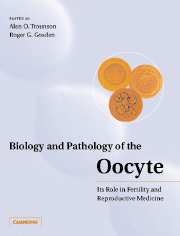Book contents
- Frontmatter
- Contents
- List of contributors
- Preface
- Part I Historical perspective
- Part II Life cycle
- Part III Developmental biology
- 6 Oocyte-specific gene expression: roles in folliculogenesis, fertilization and early development
- 7 Storage and functional recovery of molecules in oocytes
- 8 Endocrine regulation of meiosis - local and systemic hormonal influences
- 9 Checkpoint controls in mammalian oocytes
- 10 Fertilization: fate of sperm components after ICSI
- 11 Activation of the mammalian egg
- 12 Clinical applications in symmetry, asymmetry and polarity in early human development
- Part IV Pathology
- Part V Technology and clinical medicine
- Index
11 - Activation of the mammalian egg
from Part III - Developmental biology
Published online by Cambridge University Press: 05 August 2016
- Frontmatter
- Contents
- List of contributors
- Preface
- Part I Historical perspective
- Part II Life cycle
- Part III Developmental biology
- 6 Oocyte-specific gene expression: roles in folliculogenesis, fertilization and early development
- 7 Storage and functional recovery of molecules in oocytes
- 8 Endocrine regulation of meiosis - local and systemic hormonal influences
- 9 Checkpoint controls in mammalian oocytes
- 10 Fertilization: fate of sperm components after ICSI
- 11 Activation of the mammalian egg
- 12 Clinical applications in symmetry, asymmetry and polarity in early human development
- Part IV Pathology
- Part V Technology and clinical medicine
- Index
Summary
Introduction
Mammalian eggs are ovulated at the metaphase stage of the second meiotic division (Mil) and remain arrested at this stage until fertilization (Figure 11.1). The fertilizing sperm elicits a series of morphological and biochemical transformations in the egg, globally referred to as egg activation, that initiate embryo development. Meiosis resumes and the egg exits metaphase II, extrudes a second polar body and forms a haploid female pronucleus. Egg activation consists of a series of temporally and spatially controlled events. These include exocytosis of corticle granules (CGs), modifications of the egg zona pellucida as a block to polyspermy, a rise in intracellular pH, enhanced protein synthesis and, following pronuclear formation, DNA replication. Concomitantly, the inactive sperm nucleus is remodelled into a functional male pronucleus.
Many studies over several decades have increased our understanding of how the sperm may trigger egg activation at fertilization. It is uniformly accepted that, to elicit mammalian egg activation, the sperm relies on the generation of a rapid and transient increase in intracellular Ca2+, followed by repetitive intracellular Ca2+ elevations referred to as Ca2+ oscillations. Although it is clear that Ca2+ activity is necessary and sufficient for egg activation, the mechanism by which the sperm generates Ca2+ oscillations inside the egg remains to be fully unravelled. In this chapter, the hypotheses put forward will be discussed - including the much debated ‘receptor-mediated’ and ‘sperm-derived activating factor’ models - and some of the evidence as to the nature of the sperm factor will be reviewed. In mammalian cells, integrins play a crucial role in many cell signalling events through multiple intracellular signal transduction systems involving protein tyrosine kinases (PTKs)- and/or Ca2+-dependent pathways. A putative involvement of PTKs in egg activation at fertilization will be discussed and the roles of phospholipase C (PLC) and phosphoinositide (PI) turnover in this context will be addressed. Implications of inositol 1,4,5-trisphosphate (IP3) activity and of the IP3 receptor (IP3R), and evidence for the downregulation of the IP3R after fertilization in the generation of Ca2+ oscillations, will also be addressed. Finally, the recent issue of how the frequency of Ca2+ oscillations and age of the egg may determine the developmental fate of the fertilized egg will be considered.
- Type
- Chapter
- Information
- Biology and Pathology of the OocyteIts Role in Fertility and Reproductive Medicine, pp. 141 - 162Publisher: Cambridge University PressPrint publication year: 2003



